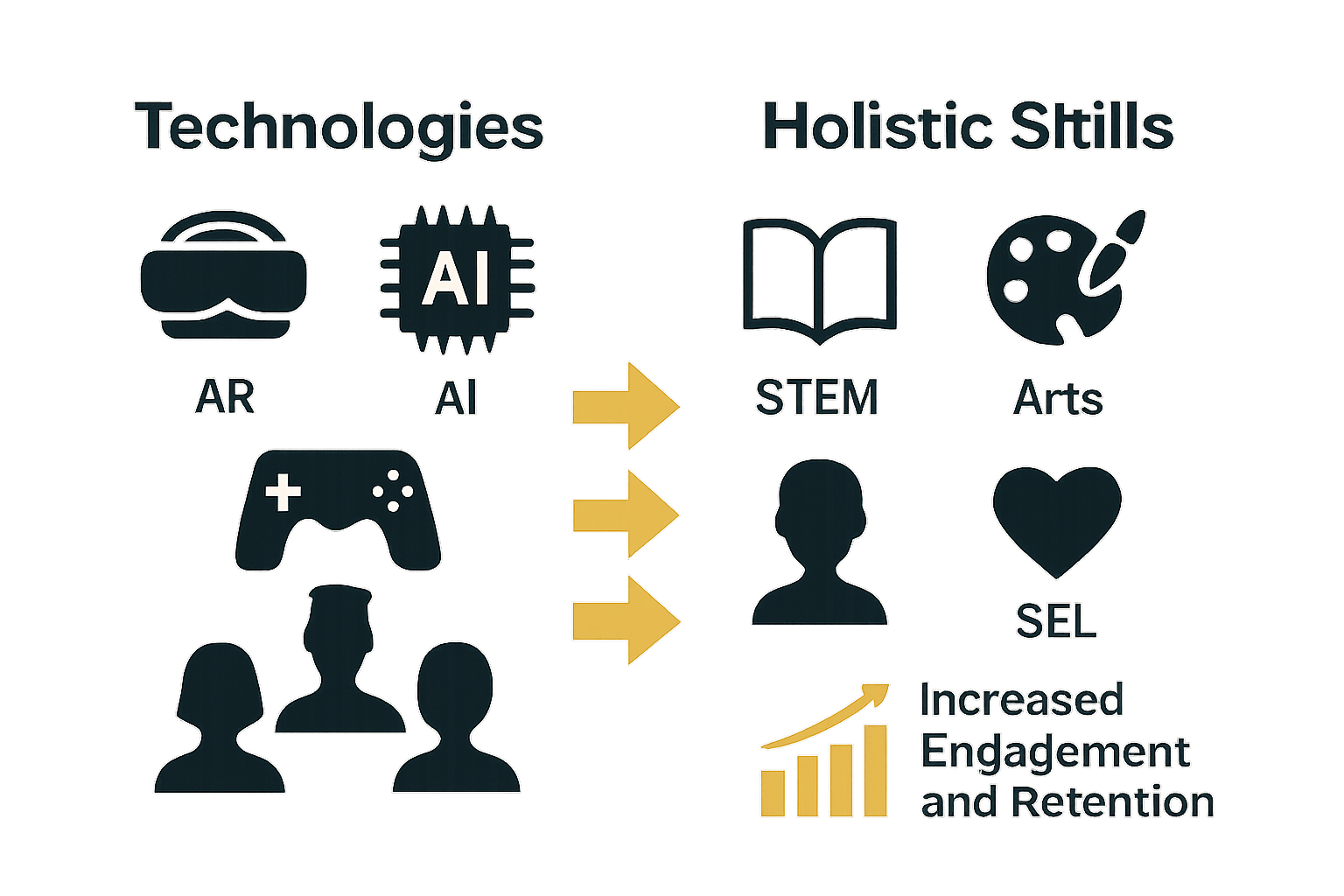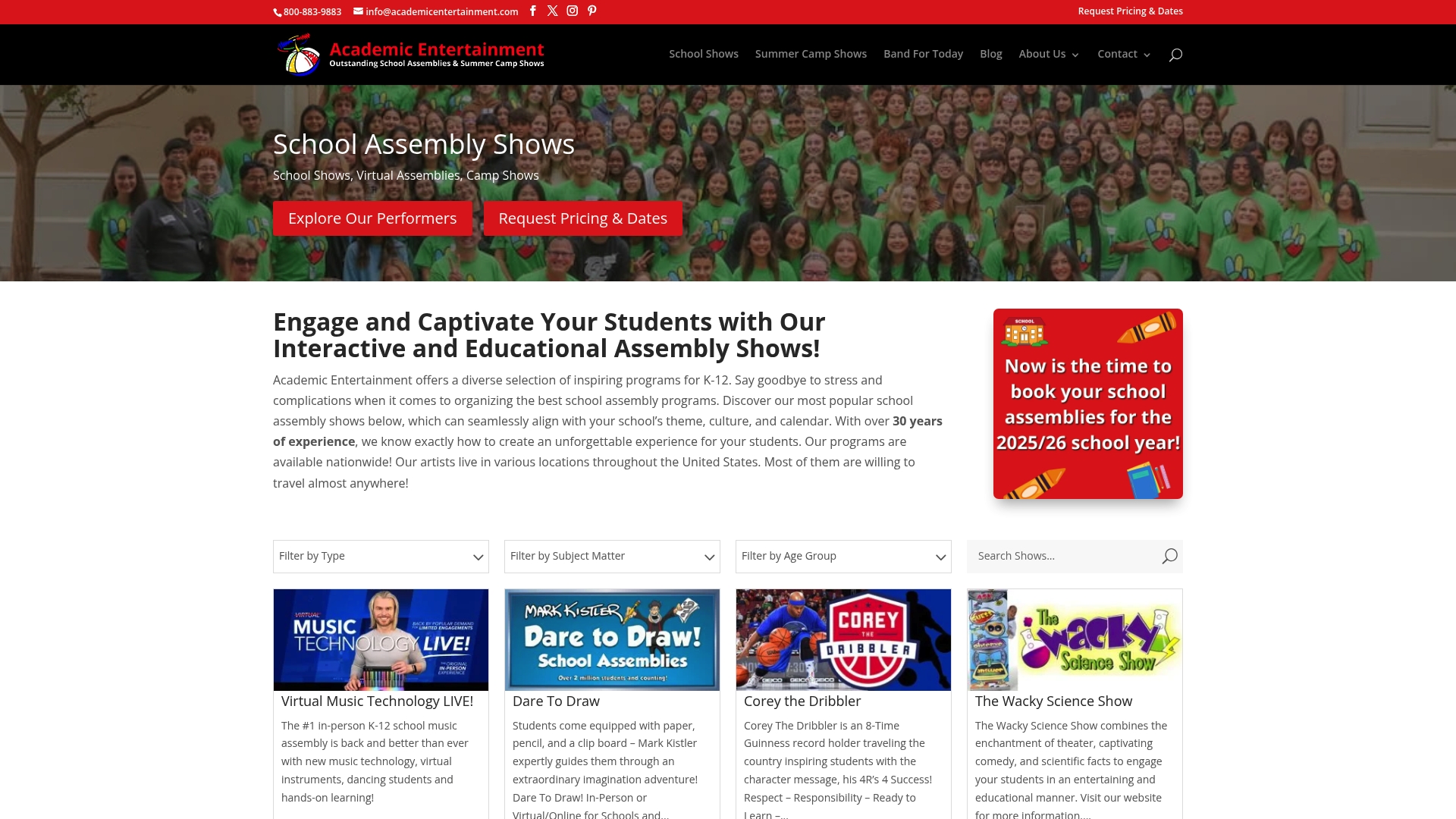Over 70 percent of schools worldwide now use digital tools to blend learning with entertainment, changing how students stay engaged. Educators notice that interactive experiences spark curiosity and help learners remember what they study. As technology keeps evolving, families and teachers are searching for fresh ways to make lessons meaningful. New trends are shaping educational entertainment, promising more tailored, immersive, and motivating experiences for every student.
Key Takeaways
| Point | Details |
|---|---|
| Technological Integration | Educational entertainment is increasingly leveraging technologies like AR, VR, and AI to create personalized and engaging learning experiences. |
| Holistic Learning Approaches | Integrating STEM, arts, and SEL themes fosters comprehensive skill development in students. |
| Emerging Learning Formats | Hybrid learning environments and interactive simulation platforms are reshaping how education is delivered, blending live and virtual experiences. |
| Strategic Program Selection | Customizing educational entertainment to align with curriculum goals ensures meaningful engagement and measurable outcomes for students. |
Defining Educational Entertainment Trends 2025
The landscape of educational entertainment is undergoing a profound transformation in 2025, driven by technological innovation and a growing understanding of how interactive experiences can revolutionize learning. According to University Research Times, edutainment represents a powerful convergence of education and entertainment that offers immersive, interactive learning experiences designed to enhance knowledge retention and student motivation.
Embracing the future, schools are increasingly adopting innovative approaches that blend technology with pedagogical strategies. OECD research highlights that artificial intelligence, virtual reality, and emerging technologies are fundamentally transforming teaching methodologies worldwide. These technological advancements enable educators to create more engaging, personalized learning environments that adapt to individual student needs.
Key trends emerging in educational entertainment for 2025 include:
Here’s a summary of emerging educational entertainment trends and their defining features:
| Trend or Technology | Core Feature | Main Benefit |
|---|---|---|
| Gamification of Learning | Game-like scenarios | Boosts motivation and engagement |
| Immersive Virtual Experiences | 360° AR/VR environments | Deepens learning through immersion |
| AI-Powered Personalization | Adaptive content | Tailors learning to individual needs |
| Collaborative Digital Platforms | Team-based tools | Encourages interaction and collaboration |
- Gamification of Learning: Interactive digital experiences that turn educational content into compelling game-like scenarios
- Immersive Virtual Experiences: Using augmented and virtual reality to create 360-degree learning environments
- AI-Powered Personalization: Adaptive learning platforms that customize educational content based on individual student performance
- Collaborative Digital Platforms: Tools that encourage student interaction and team-based problem solving
To fully leverage these emerging trends, schools and educational institutions should consider Choosing Educational Entertainment for School Success, which provides comprehensive insights into selecting the most effective educational entertainment programs that align with curriculum goals and student engagement strategies.
Emerging Formats and Interactive Technologies
The future of educational entertainment is being reshaped by groundbreaking interactive technologies that transform traditional learning experiences. arXiv researchers have developed the Spatio-Temporal Mixed and Augmented Reality Experience Description (MAR-ED) framework, which represents a significant leap forward in creating immersive educational environments that can reconstruct and interact with past events in a learner’s physical space.
Generative artificial intelligence and augmented reality are emerging as powerful tools for creating more engaging educational experiences. Another fascinating research development from arXiv highlights a reference architecture for cultural heritage applications that leverages these technologies to dramatically enhance user engagement and educational impact. This approach demonstrates how cutting-edge technologies can breathe new life into educational content, making learning more interactive and memorable.
Key emerging interactive technologies include:
- Augmented Reality (AR) Learning Environments: Overlaying digital information onto real-world spaces
- Generative AI Educational Content: Dynamically creating personalized learning materials
- Immersive Simulation Platforms: Creating realistic, interactive learning scenarios
- Adaptive Learning Technologies: Platforms that adjust content based on individual student performance
To explore these innovative approaches further, educators can understand interactive learning experiences that are transforming educational engagement and creating more dynamic, personalized learning journeys for students.
Incorporating STEM, Arts, and SEL Themes
Educational entertainment is evolving to create holistic learning experiences that integrate multiple disciplines and critical skill development. arXiv researchers have highlighted the potential of Interactive Digital Narratives (IDNs) as powerful tools for developing complex cognitive skills, combining systems thinking, design thinking, and storytelling to address sophisticated societal challenges.
The integration of STEM, arts, and Social Emotional Learning (SEL) represents a comprehensive approach to student development. Wikipedia research demonstrates how gamification can motivate students by incorporating engaging elements like narrative progression, immediate feedback, and interactive learning mechanics. This approach allows educators to create multidimensional learning experiences that go beyond traditional subject boundaries.

Key strategies for incorporating integrated themes include:
- Interdisciplinary Storytelling: Creating narratives that connect STEM concepts with artistic expression
- Problem-Based Learning: Designing challenges that require technical, creative, and emotional intelligence
- Collaborative Project Frameworks: Encouraging teamwork that develops both technical and social skills
- Adaptive Learning Experiences: Personalizing content to address individual learning needs and emotional development
To ensure these approaches align with educational goals, schools can understand how programs connect to STEM and STEAM learning goals, which provides critical insights into creating meaningful, integrated educational experiences that support comprehensive student growth.

Applications for Live and Virtual School Programs
The landscape of educational programming is rapidly transforming, with innovative technologies creating dynamic learning experiences that transcend traditional classroom boundaries. Wikipedia highlights how augmented reality is revolutionizing educational settings by superimposing text, graphics, video, and audio directly into students’ real-time environments, enhancing interactive and immersive learning opportunities.
arXiv research reveals the emergence of Metaverse-based educational applications that utilize extended reality and the Internet of Everything to create comprehensive virtual worlds for education, training, and skill development. These technologies are blurring the lines between live and virtual programming, offering unprecedented flexibility and engagement for students across different learning contexts.
Key applications for live and virtual school programs include:
- Hybrid Learning Environments: Seamlessly integrating in-person and digital educational experiences
- Interactive Simulation Platforms: Creating realistic scenarios for hands-on learning
- Real-Time Collaborative Spaces: Enabling student interaction across geographical boundaries
- Personalized Learning Pathways: Adapting content delivery to individual student needs
To navigate these emerging educational technologies, schools can explore comprehensive virtual school programming guides that provide strategic insights into implementing innovative digital learning solutions that maximize student engagement and educational outcomes.
Choosing and Customizing Educational Entertainment
Wikipedia reveals that educational video games represent a sophisticated approach to learning, masterfully merging entertainment with targeted educational content designed to align seamlessly with school curricula. This integration creates powerful learning experiences that engage students through interactive and compelling formats.
Wikipedia further highlights how digital media in education supports and enhances teaching processes by offering personalized and interactive learning experiences. The key to successful educational entertainment lies in its ability to adapt to diverse student needs, learning styles, and educational objectives.
Key considerations for choosing and customizing educational entertainment include:
- Curriculum Alignment: Ensuring content directly supports academic learning goals
- Age-Appropriate Design: Matching complexity and engagement level to student developmental stages
- Interactive Elements: Incorporating participatory components that promote active learning
- Measurable Learning Outcomes: Selecting programs with clear educational performance metrics
- Technological Compatibility: Ensuring seamless integration with existing school technologies
To navigate the complex landscape of educational entertainment selection, schools can learn how to select educational programs for optimal learning, which provides strategic insights into identifying and implementing the most effective and engaging educational experiences.
Transform Educational Entertainment Trends Into Impactful School Experiences
The 2025 wave of educational entertainment is about creating immersive, personalized learning environments that deeply engage students through gamification, virtual reality, and AI-driven personalization. Yet, bringing these innovative trends into your school can feel overwhelming. You want programs that not only align with STEM, arts, and social-emotional goals but also spark real excitement and lasting lessons in students.
At Academic Entertainment, we understand the challenge of selecting and customizing educational entertainment that truly connects with your school’s unique themes and objectives. With over 40 years of experience delivering tailored live and virtual programs that combine science, character education, cultural performances, and more, we make it easy to bring cutting-edge trends like interactive digital narratives and immersive learning straight into your classrooms.
Explore how to choose educational entertainment for school success and gain insights into understanding interactive learning experiences that maximize student engagement and motivation.

Ready to transform the future of learning with entertaining, curriculum-aligned programs designed for today’s dynamic educational landscape? Visit Academic Entertainment now to discover the perfect shows that will inspire and empower your students today.
Frequently Asked Questions
What are the key trends in educational entertainment for 2025?
Key trends include gamification of learning, immersive virtual experiences, AI-powered personalization, and collaborative digital platforms. These trends enhance student engagement and adapt learning to individual needs.
How can schools implement immersive virtual experiences in education?
Schools can implement immersive virtual experiences by utilizing augmented reality (AR) and virtual reality (VR) technologies to create 360-degree learning environments that deepen student understanding through interactive scenarios.
What role does artificial intelligence play in educational entertainment?
Artificial intelligence in educational entertainment allows for AI-powered personalization, where adaptive learning platforms customize educational content based on individual student performance to enhance learning effectiveness.
How does integrating STEM, arts, and SEL enhance educational entertainment?
Integrating STEM, arts, and Social Emotional Learning (SEL) into educational entertainment creates holistic learning experiences that foster complex cognitive skills, encourage teamwork, and promote both technical and social development.
Recommended
- The Essential Guide to Value of School Entertainment – Academic Entertainment
- Understanding Benefits of Educational Entertainment for Parents – Academic Entertainment
- Choosing Educational Entertainment for School Success – Academic Entertainment
- What Is Educational Variety in Schools? Complete Guide – Academic Entertainment
- 7 Key EdTech Trends in 2025 for Malaysian Innovators – Projector Display
- 5 Effective TEFL Teaching Methods for Young English Learners




